Biochemical recommendations for people in prolonged pain
Deficiencies and insufficiencies of certain metabolites have been seen in many chronic pain conditions and can create a predisposition to the activation of trigger points and subsequent perpetuation of myofascial pain syndromes. Deficiencies are values that fall outside the normal range. Insufficiencies can be found in the low parts of range and can be equally problematic whenever demand is high.
The following table has been compiled according to the recommendations of Robert Gerwin MD, Pain and Rehabilitation Medicine, Bethesda, MD; Tim Taylor, MD and Anna Bittner, MD, of Pain Relief Home, Richmond, VA. Support studies are quoted in the text books ‘Myofascial Pain and Dysfunction’ by Travell & Simons, ‘Trigger Point Therapy for Low Back Pain’ by Sauer & Biancalana and ‘Myofascial Trigger Points’ by Dommerholt & Huijbregts.
Supplement |
Normal Range for |
We recommend | |
| Men | Women | ||
Test results should be at or greater than the following values |
|||
| Ferritin (the storage form of iron) |
50 ng/ml | Eating red meat remains the best delivery system for iron. Spirulina etc. can help vegetarians. Take iron tablets with vitamin C | |
| Vitamin B1 (thiamin) | 4.0 mcg/l | ||
| Vitamin B6 | 5.4-6.7 mcg/l | 2.0-2.8 mcg/l | |
| Vitamin B12 | 350 pcg/ml | Found in animal protein | |
| Vitamin D3 (25-OH) | 50 ng/ml | Take Vitamin D3 with fatty food. |
|
| Serum Folate | 5.4 mg/ml | ||
Test results should fall within the following ranges |
|||
| Thyroid Stimulating Hormone (TSH) | 0.4-2.0 micro IU/ml | Hypothyroidism is mostly a female condition | |
| Serum Calcium | 8.5-10.6 mg/dl | ||
| Red cell Magnesium | 1.7 – 4.5 mg/dl | Magnesium malate has less side-effects | |
| Serum Potassium | 3.5-5.2 mmoll | ||
Anti-inflammatory and Pro-inflammatory foods |
|
| Anti-inflammatory | Pro-inflammatory |
Fruits |
Refined grains |
Reference: Liebenson C. Rehabilitation of the Spine, 2nd Edition (2007), Chapter 30, page 730 ‘Nutritional Considerations for Inflammation and Pain’ by David R. Seaman DC









